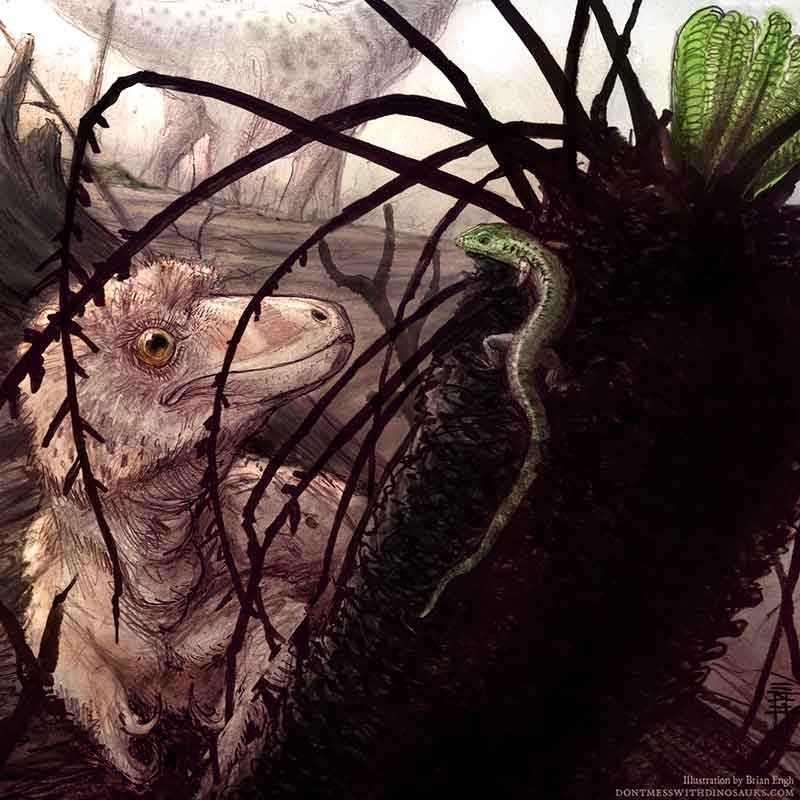Fossils of Two Early Cretaceous Species Discovered in Southwest Arkansas

An illustration of the new species of skink, Sciroseps pawhuskai, discovered in southwest Arkansas.
Two new species dating back to the Early Cretaceous Period were recently discovered in Sevier County in southwest Arkansas. One is a small skink researchers named Sciroseps pawhuskai and the other is a new fish named Anomoeodus caddoi.
The discoveries serve both to underscore the variety of fossils found at this site, including dinosaurs, mammals, fish, amphibians and reptiles, and to reinforce the overall lack of variety of fossils found throughout North America during the Early Cretaceous, roughly 110 million years ago.
The discoveries were highlighted in a recent paper published in PeerJ, titled “A new vertebrate fauna from the Lower Cretaceous Holly Creek Formation of the Trinity Group, southwest Arkansas, USA.” Celina Suarez, associate professor of geosciences at the U of A, served as primary author on the article, which pulls together decades of research in the area, known as the Holly Creek Formation.
While Arkansas is not traditionally considered a fertile source of Early Cretaceous fossils, this location has been unusually rich in them — including dinosaur tracks. Since the 1970s, thousands of sauropod and theropod tracks have been discovered in the area.
More recent work reveals that this ancient coastal plain of Arkansas was inhabited by a wide variety of freshwater and land animals, including long-necked dinosaurs, large carnivores, raptor-like carnivores and armored dinosaurs. But the site also provides a wide assortment of fossilized bones and teeth of much smaller creatures, such as sharks, fish, frogs, lizards, turtles and crocodilians, providing a clearer picture of the overall ecosystem at that time.
 |
| Celina Suarez, associate professor of geosciences at the University of Arkansas. |
While the study enriches our knowledge of ancient fauna in Arkansas, it also serves to confirm that North America did not have as wide a variety of species in the Early Cretaceous as it did in the Late Cretaceous (roughly 70 million years ago). By and large, the majority of fauna found in the Holly Creek Formation are similar to fauna found throughout North America at the same time.
What caused increased diversity of life between the Early and Late Cretaceous Periods? The papers suggest that plate tectonics, which created mountains in the west, and climate changes, which drove rising sea levels, led to increased geographic isolation among similar species, spurring evolutionary changes in separated populations.
“When habitats are fragmented it can cause evolutionary changes,” Suarez explained. “One way this and other discoveries from the Cretaceous of North America can help us understand the modern world is how climate change can affect evolution of animals, be it extinction or the origination of new species. Given that the Cretaceous was a period of rapidly warming and cooling worlds, understanding these time periods is important for understanding how future warming worlds will react to climate change.”
Suarez also noted that she and her colleagues from other universities have been working to describe and catalogue many discoveries from southwest Arkansas since she arrived at the U of A in 2012. This paper is the first time so many specimens have been reported from a single site.
Suarez’s co-authors included Joseph Frederickson, Richard L. Cifelli, Jeffrey G. Pittman, Randall L. Nydam, ReBecca K. Hunt-Foster and Kirsty Morgan.
About the Department of Geosciences: The Department of Geosciences traces its origin to 1873 when the first mineralogy course was offered at the University of Arkansas. Our faculty and students examine the processes that form and shape Earth's surface, the natural resources we use, how water and ecosystems are interconnected, variations in climate and paleoclimate, the use and development of geospatial methods, and the human geography of ethnicity, gender, class, social inequity, and religion. The department earned $2 million in research awards in FY 2020, and our students benefit from over $3 million in endowed scholarship funds contributed by generous alumni. To learn more about the Department of Geosciences please visit our website.
About the University of Arkansas: As Arkansas' flagship institution, the U of A provides an internationally competitive education in more than 200 academic programs. Founded in 1871, the U of A contributes more than $2.2 billion to Arkansas’ economy through the teaching of new knowledge and skills, entrepreneurship and job development, discovery through research and creative activity while also providing training for professional disciplines. The Carnegie Foundation classifies the U of A among the top 3% of U.S. colleges and universities with the highest level of research activity. U.S. News & World Report ranks the U of A among the top public universities in the nation. See how the U of A works to build a better world at Arkansas Research News.
Topics
Contacts
Celina Suarez, associate professor
Department of Geosciences
479-575-4866,
casuarez@uark.edu
Hardin Young, assistant director of research communications
University Relations
479-575-6850,
hyoung@uark.edu
Headlines
Four Students Named Goldwater Scholars; Two Earn Udall Honorable Mentions
Four U of A students have received the prestigious Goldwater Scholarship, an award for top students in mathematics, science, and engineering.
Cross-Campus Collaboration Culminates in New Outdoor Geological Installation
Grand opening event to celebrate the new GeoLab installation at the U of A’s Gearhart Hall courtyard is set for May 3. The installation will be open to the public year-round.
First Students to Use Online Degree to Hone Nursing Leadership, Elevate Patient Care
Hanna Baxendale and Wendi Kimbrell will begin coursework in the Doctor of Nursing Practice-Executive Master of Business Administration program offered by the Eleanor Mann School of Nursing and Walton College.
Join the Office for Sustainability on a Final Cruise to Campus
Cruise to Campus Wednesdays have fostered a gathering space for individuals interested in biking to campus. Drop by the Old Main Lawn from 7:30-10 a.m. Wednesday for coffee, something to eat and conversation.
Fay Jones School Student Ambassador Program Gives Voice to Design Students
The student ambassador program at the Fay Jones School of Architecture and Design is built to connect top design students with their school, its alumni, its future students and others inside and outside the school.




